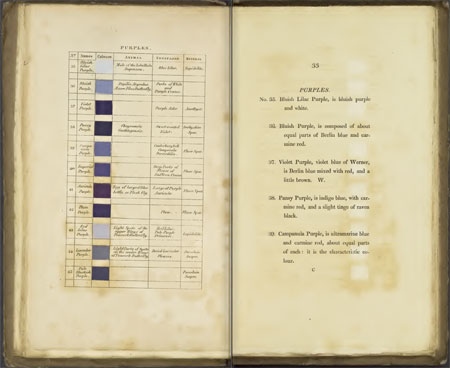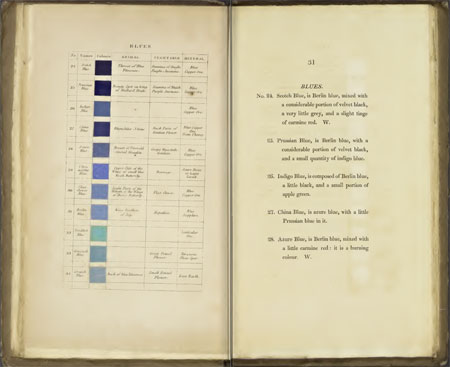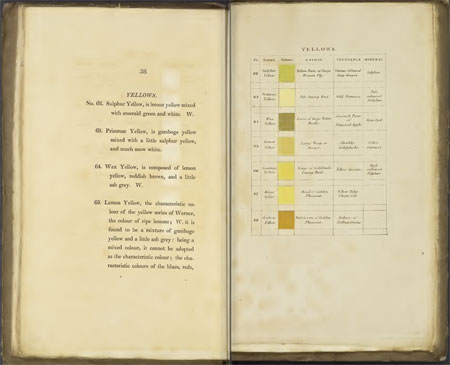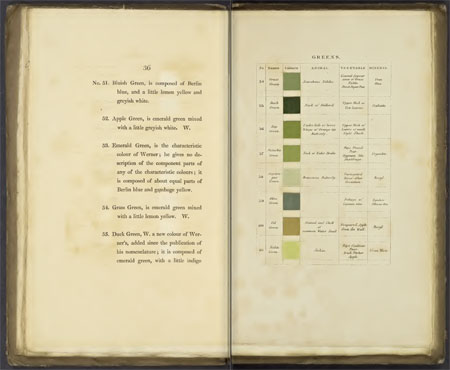German geologist Abraham Gottlob Werner developed a detailed nomenclature – or naming system – colour guide published in 1821 under the flowery title of Werner’s nomenclature of colours : with additions, arranged so as to render it highly useful to the arts and sciences, particularly zoology, botany, chemistry, mineralogy, and morbid anatomy : annexed to which are examples selected from well-known objects in the animal, vegetable, and mineral kingdoms.
 Between the pages of this mouthful of a title is a type of colour dictionary which long predates Pantone colour swatches. It is an attempt to describe the colours of the natural world through the observational lens of science. Before photography, naturalists described visual details – however, they could be ambiguous, so Werner’s more scientific approach meant that his book became a standard reference for colour scheme scientists. For instance, Charles Darwin used Werner’s terminology to identify colours he saw in plants and animals during his voyage on the HMS Beagle.
Between the pages of this mouthful of a title is a type of colour dictionary which long predates Pantone colour swatches. It is an attempt to describe the colours of the natural world through the observational lens of science. Before photography, naturalists described visual details – however, they could be ambiguous, so Werner’s more scientific approach meant that his book became a standard reference for colour scheme scientists. For instance, Charles Darwin used Werner’s terminology to identify colours he saw in plants and animals during his voyage on the HMS Beagle.
 Werner’s descriptions of each colour are quite precise but they sound charming to modern ears. For instance, number 44 – Lavender Purple is described as the “Light parts of spots on the underwings of the Peacock Butterfly”. Number 23 – Velvet black is to match the Male Tail feathers of the Black Cock. Number 7 – Skimmed milk white is the same as the “White of Human Eyeballs” and Number 51 is a Blueish Green that is the same as “Egg of Thrush”
Werner’s descriptions of each colour are quite precise but they sound charming to modern ears. For instance, number 44 – Lavender Purple is described as the “Light parts of spots on the underwings of the Peacock Butterfly”. Number 23 – Velvet black is to match the Male Tail feathers of the Black Cock. Number 7 – Skimmed milk white is the same as the “White of Human Eyeballs” and Number 51 is a Blueish Green that is the same as “Egg of Thrush”
 There are 110 colours in all. It would be great fun to try and mix the exact shade of each colour. It would make a wonderful exercise, as, if you mixed the colours, you would discover hundreds of others along the way. By the end of it, you would know a thing or two about colour mixing! I might just set it as a personal challenge when I get back from our travels, as there is always something to learn about colour, and no matter what you name each colour, you can never do too much colour mixing/matching.
There are 110 colours in all. It would be great fun to try and mix the exact shade of each colour. It would make a wonderful exercise, as, if you mixed the colours, you would discover hundreds of others along the way. By the end of it, you would know a thing or two about colour mixing! I might just set it as a personal challenge when I get back from our travels, as there is always something to learn about colour, and no matter what you name each colour, you can never do too much colour mixing/matching.
 The publication is now open source and Werner’s nomenclature of colours is found on the internet archive here
The publication is now open source and Werner’s nomenclature of colours is found on the internet archive here
Subscribe!
Have Inaminuteago delivered to your inbox by using the ‘follow’ feature in the sidebar. If you are on a mobile or tablet you will need to scroll to the bottom to find the ‘follow’ feature. Just enter your email address, and when you get the confirmation email make sure you say ‘yes’ and you are all set!

Thank you for sharing such a fascinating treasure with your readers.
What a fascinating book and thank you for sharing it with us all. I had no idea if its existence.